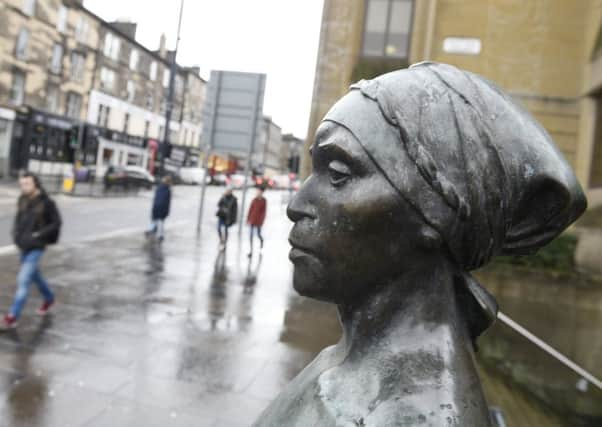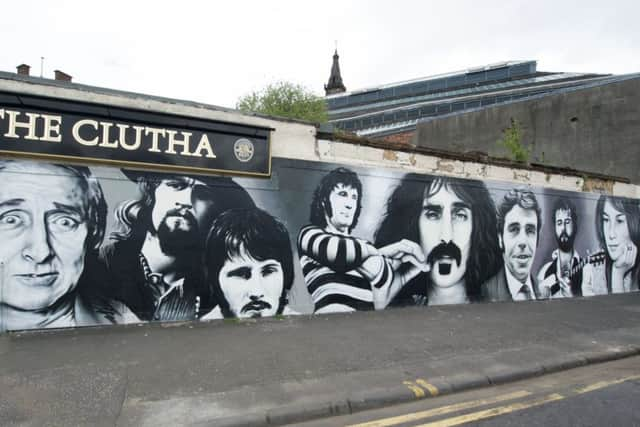Where are the statues of Scots women?


All told, there are five statues of men close to St Giles’ Cathedral on the High Street – philosopher and economist Adam Smith, James Braidwood, who founded the world’s first municipal fire service in Edinburgh, and Charles II are the others – and not a single representation of a woman.
This small patch of land reflects the situation in the wider city – and indeed Scotland as a whole. In Edinburgh, there are at least three statues to named animals – Greyfriars Bobby, Bum the dog (a similarly faithful hound from Edinburgh’s twin city, San Diego) and Wojtek, a “soldier” bear adopted by Polish troops in the Second World War, but only two to a named woman; and both of them are of Queen Victoria. There is also a small sculpture called Woman And Child by Anne Davidson on Festival Square which marks Edinburgh’s stand against apartheid. It’s a small work sandwiched, on the day I visit, between a litter bin and a grit bin. In Glasgow there are three statues of women – Queen Victoria, philanthropist Isabella Elder and Republican Spanish Civil War hero Dolores Ibarruri. Across Scotland, there are 20: five of them are Queen Victoria and one is Mary, Queen of Scots.
Advertisement
Hide AdAdvertisement
Hide Ad“I’m not very interested in statues, but I am bothered by what the absence of women represents,” says Lindsay Harger, 33, who is originally from Indiana, but is living in St Andrews and visiting the capital for a couple of days. “I mean if you can have statues of dogs, then why not women?”


Many of the city’s statues were erected during the Victorian era, but three of the five around St Giles’ – Adam Smith and David Hume, by Sandy Stoddart, and James Braidwood, by Kenny Mackay, have been put up within the past 25 years, so the problem cannot be dismissed as the unfortunate legacy of a bygone era. A new statue to architect William Henry Playfair – also by Stoddart – will be unveiled later this year.
“Come on, this is Edinburgh, this is the 21st century, there are many great Scottish women. Couldn’t something be done about this?” asks Laia Coll, 23, who is from Barcelona, but has been living in the city for two-and-a-half years. “Young girls ought to have more female role models to look up to.”
The problem isn’t confined to statues, of course; whether it’s plaques, memorial stones or stained glass windows, women are consistently under-represented in our public spaces and, despite much awareness-raising, progress is slow.
This year, as in the past three years, Historic Environment Scotland, will be putting up another batch of plaques honouring great Scots. Last week, it renewed its call for nominations, offering a valuable opportunity for women’s achievements to be trumpeted.


Yet its track record isn’t particularly good. In 2013 and 2014 combined, the organisation put up plaques to 21 men and two women. Last year – under pressure from culture secretary Fiona Hyslop – it upped its game, with three out of eight plaques dedicated to women. One of these celebrated “the Edinburgh Seven”, the first women to be admitted to a degree programme anywhere in Britain. The independent panel Historic Environment Scotland appoints to make the final selection is always gender-balanced and, together with the Marie Stuart Society, the organisation was responsible for the statue of Mary, Queen of Scots, unveiled at Linlithgow Palace in April. “We are aware of the need for more women, but we are limited in what we can do as we can’t steer people in the direction of a particular candidate,” a spokesman said.
There are, of course, other plaques put up by churches, city councils or community groups, but in this as in everything else, the number celebrating men far outweighs the number celebrating women. “Even when I think of the buildings at Edinburgh University – so many are named after men, so few after women, and putting this right wouldn’t cost much,” says Coll.
Advertisement
Hide AdAdvertisement
Hide AdDespite the gap, campaigns to create more monuments to women struggle to gain the necessary momentum. Maquettes by rival sculptors competing to create a statue of Mary Barbour – the crusader who led the Glasgow rent strikes of 1915 – have been touring, but plans hit a setback late last year when Creative Scotland turned down a grant application because of a “lack of community engagement”. And a long-running campaign for a statue of Dr Elsie Maud Inglis, who set up the Scottish Women’s Hospitals in war zones in the First World War, has also so far failed to gain sufficient traction. Last year, a set of stamps honouring Inglis and four other Scots was issued in Serbia, but the lack of proper acknowledgement of these women in their homeland is a festering sore.
Meanwhile, celebrities including Irvine Welsh and Robert Carlyle have put their weight behind a statue for boxer Benny Lynch at Glasgow Central Station, and a petition calling for Glasgow City Council to fund a statue of Billy Connolly has been set up by Radio Clyde..
Though it is not a peculiarly Scottish phenomenon, the failure to commemorate the nation’s great women in our public spaces has been a talking point since at least the mid-90s. Back then, Edinburgh City Council set up a Women of Achievement Trail – a series of 20 plaques to women including Inglis, Scottish businesswoman and philanthropist Mary Erskine and writers Naomi Mitchison, Susan Ferrier and Muriel Spark.
But even as Edinburgh tried to rectify historic wrongs, new ones were being committed. When the new Scottish parliament was built, 24 quotes were chosen to be inscribed in the Canongate Wall; and not a single one of them was by a woman (one was added later in the face of public anger).
With gender equality high on the political agenda, it is difficult to imagine that happening today. Indeed, the Scottish parliament is currently holding an exhibition of John Bellany paintings inspired by the work done by Inglis and the other female medics.
Yet – away from the politically correct environment of Holyrood – there is still a tendency to omit women from public artworks, even when the people portrayed are from the 20th or 21st century. When a new mural was unveiled on the side of Glasgow’s Clutha pub last year many were dismayed to find just two women – Mary Barbour and Glenda Jackson – amongst a sea of men.
In Edinburgh, walking tour guide and photographer David Guillen, from Madrid, says he too is struggling to find women for a project documenting the life of the Royal Mile. “I have been photographing the main characters who represent the street – the soldiers up at the castle, the priest, the banker, the lawyer and these people are mostly men,” he says. “It’s a sad thing. I want to include everyone and yet still I find 90% of my pictures are men.”
Advertisement
Hide AdAdvertisement
Hide AdDr Alison McCall, convener of Women’s History Scotland, says women’s under-representation in the civic landscape has been partly due to the way they viewed themselves. “A lot of the women we would want to honour are women who saw a problem and set about solving it. They didn’t donate their diaries to an archive because they weren’t thinking of their own personal glorification,” she says.
When we look at the dearth of memorials to women, there is a tendency to assume it’s because women’s achievements were not acknowledged by their own contemporaries, but this is not always the case. According to McCall, figures such as Lady Aberdeen – a writer and philanthropist who played a key role in the setting up of the League of Nations – were well-known and widely reported in their own day, only to fall out of the public consciousness later on. (The only tributes to Lady Aberdeen are a small bust in Aberdeen Museum and a plaque in Methlick Parish Church).
“Sometimes these women are deliberately written out of the history books,” says McCall. She tells the story of Christian Farquharson-Kennedy, a communist also from Aberdeen. She died in her 40s before women got the vote, otherwise she would probably have become an MP as her husband later did.
“One of the history books has suggested her role was simply to support her husband,” says McCall. “But she went to Paris as a delegate to an international political conference five years before she met him.”
Whatever its roots, the effacement of women is a self-perpetuating problem: there are fewer monuments to women, so we know less about them, so when it comes to choosing candidates for future monuments they are less likely to make the cut.
McCall is one of the voluntary administrators for Mapping Memorials to Women in Scotland – a project set up by Women’s History Scotland and the Glasgow Women’s Library to help reclaim women’s stories. Basically, it does what it says on the tin: people from across the country look out for any memorials to women – plaques, cairns, windows, street names – and add them to a website so they can be plotted on a map. So far, they have charted 600 – from the blue plaque dedicated to “battling” Betty McAllister, a social justice campaigner from Glasgow’s East End, to a memorial to medical pioneer and suffragette Flora Murray in Dalton Parish Church near Lockerbie.
Documenting influential women in this way is important, but many of these memorials are tucked away. They do not dominate our public squares in the way grand monuments to men do.
Advertisement
Hide AdAdvertisement
Hide AdIn Manchester, there are 17 statues of men and only one of a woman (the ubiquitous Queen Victoria) so councillor Andrew Simcock decided to ask people to pick a woman from a shortlist of 20 and then raise money to erect a statue in her honour. He cycled from Land’s End to John O’ Groats, promoting a different woman from the shortlist every day. Last week, he revealed the suffragette, Emmeline Pankhurst, had won. He now hopes to draw up a gender-balanced shortlist of potential sculptors and have the public vote on submissions.
But are great statues – with their overtones of Empire – necessarily the best way of celebrating women’s achievements? Glasgow Women’s Library also runs several heritage walks which explore the rich diversity of women who have added to the colour, life and success of the city.
Enterprise development manager Sue John says: “Our civic landscape is littered with [monuments] celebrating the achievements of our great men, quite rightly. But when we look round, the absence of statues or streets or buildings named after Scotland’s women does beg the question: ‘Have they done anything great?’ Of course, we know plenty of them have, so there needs to be more recognition. That’s a no-brainer. But I think it’s how we celebrate women’s achievements that is an interesting thing to grapple with.”
Looking for an alternative to statues, GWL has explored new ways to mark women’s contributions through public artworks. In 2010, its Making Spaces project culminated in two installations – Shauna McMullan’s Blue Spine, 500 books with blue spines written by women from across Scotland, and Nicky Bird’s Unsorted Donations, which saw visitors walking through a maze of cardboard boxes and wooden pallets listening to snatches of women’s stories told in their own voices.
In addition, there is always the potential for more plaques. Historic Environment Scotland’s nominations are open until next Sunday, so there’s still time to put the case for those great Scottish women whose lives have so far gone unacknowledged, their praises unsung.